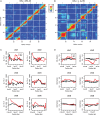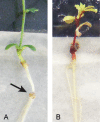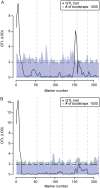A set of Lotus japonicus Gifu x Lotus burttii recombinant inbred lines facilitates map-based cloning and QTL mapping
- PMID: 22619310
- PMCID: PMC3415293
- DOI: 10.1093/dnares/dss014
A set of Lotus japonicus Gifu x Lotus burttii recombinant inbred lines facilitates map-based cloning and QTL mapping
Abstract
Model legumes such as Lotus japonicus have contributed significantly to the understanding of symbiotic nitrogen fixation. This insight is mainly a result of forward genetic screens followed by map-based cloning to identify causal alleles. The L. japonicus ecotype 'Gifu' was used as a common parent for inter-accession crosses to produce F2 mapping populations either with other L. japonicus ecotypes, MG-20 and Funakura, or with the related species L. filicaulis. These populations have all been used for genetic studies but segregation distortion, suppression of recombination, low polymorphism levels, and poor viability have also been observed. More recently, the diploid species L. burttii has been identified as a fertile crossing partner of L. japonicus. To assess its qualities in genetic linkage analysis and to enable quantitative trait locus (QTL) mapping for a wider range of traits in Lotus species, we have generated and genotyped a set of 163 Gifu × L. burttii recombinant inbred lines (RILs). By direct comparisons of RIL and F2 population data, we show that L. burttii is a valid alternative to MG-20 as a Gifu mapping partner. In addition, we demonstrate the utility of the Gifu × L. burttii RILs in QTL mapping by identifying an Nfr1-linked QTL for Sinorhizobium fredii nodulation.
Figures




Similar articles
-
High-resolution genetic maps of Lotus japonicus and L. burttii based on re-sequencing of recombinant inbred lines.DNA Res. 2016 Oct 1;23(5):487-494. doi: 10.1093/dnares/dsw033. DNA Res. 2016. PMID: 27374610 Free PMC article.
-
Lotus burttii takes a position of the third corner in the lotus molecular genetics triangle.DNA Res. 2005 Feb 28;12(1):69-77. doi: 10.1093/dnares/12.1.69. DNA Res. 2005. PMID: 16106754
-
A Promiscuity Locus Confers Lotus burttii Nodulation with Rhizobia from Five Different Genera.Mol Plant Microbe Interact. 2022 Nov;35(11):1006-1017. doi: 10.1094/MPMI-06-22-0124-R. Epub 2022 Oct 31. Mol Plant Microbe Interact. 2022. PMID: 35852471
-
Classical and molecular genetics of the model legume Lotus japonicus.Mol Plant Microbe Interact. 1997 Jan;10(1):59-68. doi: 10.1094/MPMI.1997.10.1.59. Mol Plant Microbe Interact. 1997. PMID: 9002271
-
QTL mapping using high-throughput sequencing.Methods Mol Biol. 2015;1284:257-85. doi: 10.1007/978-1-4939-2444-8_13. Methods Mol Biol. 2015. PMID: 25757777 Review.
Cited by
-
The Rhizobia-Lotus Symbioses: Deeply Specific and Widely Diverse.Front Microbiol. 2018 Sep 12;9:2055. doi: 10.3389/fmicb.2018.02055. eCollection 2018. Front Microbiol. 2018. PMID: 30258414 Free PMC article. Review.
-
Atypical Receptor Kinase RINRK1 Required for Rhizobial Infection But Not Nodule Development in Lotus japonicus.Plant Physiol. 2019 Oct;181(2):804-816. doi: 10.1104/pp.19.00509. Epub 2019 Aug 13. Plant Physiol. 2019. PMID: 31409696 Free PMC article.
-
High-resolution genetic maps of Lotus japonicus and L. burttii based on re-sequencing of recombinant inbred lines.DNA Res. 2016 Oct 1;23(5):487-494. doi: 10.1093/dnares/dsw033. DNA Res. 2016. PMID: 27374610 Free PMC article.
-
A collection of novel Lotus japonicus LORE1 mutants perturbed in the nodulation program induced by the Agrobacterium pusense strain IRBG74.Front Plant Sci. 2024 Jan 5;14:1326766. doi: 10.3389/fpls.2023.1326766. eCollection 2023. Front Plant Sci. 2024. PMID: 38250449 Free PMC article.
-
Exploring DNA variant segregation types in pooled genome sequencing enables effective mapping of weeping trait in Malus.J Exp Bot. 2018 Mar 24;69(7):1499-1516. doi: 10.1093/jxb/erx490. J Exp Bot. 2018. PMID: 29361034 Free PMC article.
References
-
- Kruger M., Kruger C., Walker C., Stockinger H., Schussler A. Phylogenetic reference data for systematics and phylotaxonomy of arbuscular mycorrhizal fungi from phylum to species level. New Phytol. 2012;193:970–84. - PubMed
-
- Schauser L., Roussis A., Stiller J., Stougaard J. A plant regulator controlling development of symbiotic root nodules. Nature. 1999;402:191–5. - PubMed
Publication types
MeSH terms
LinkOut - more resources
Full Text Sources
Miscellaneous

